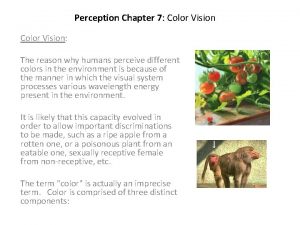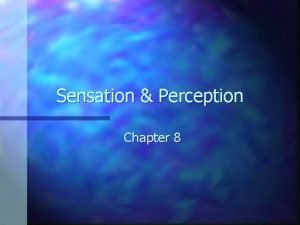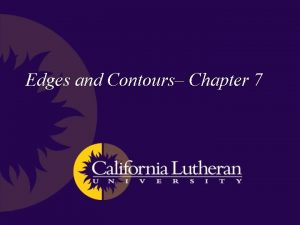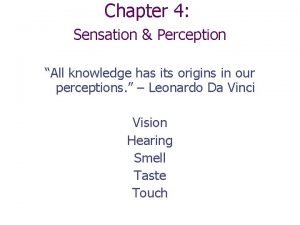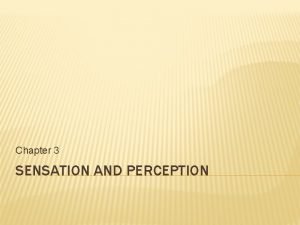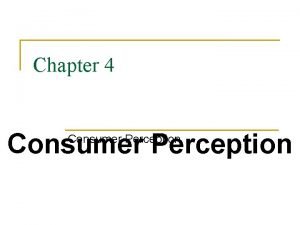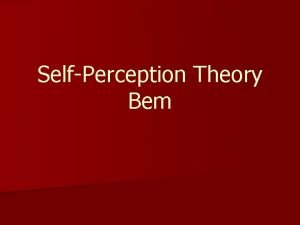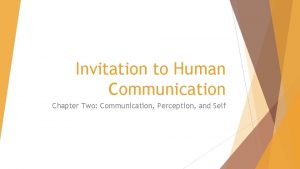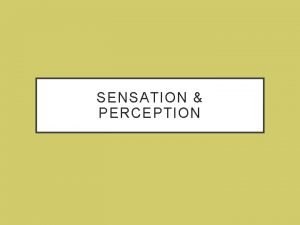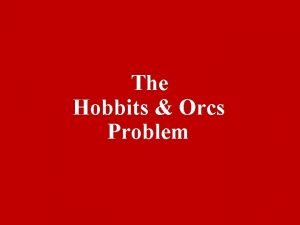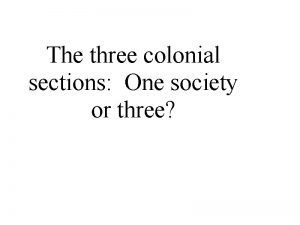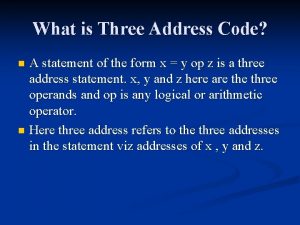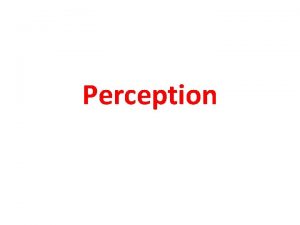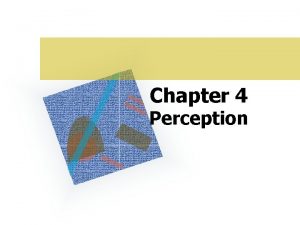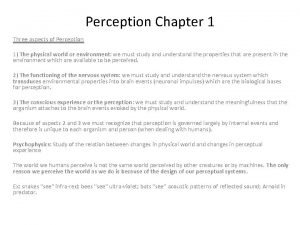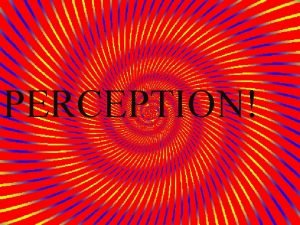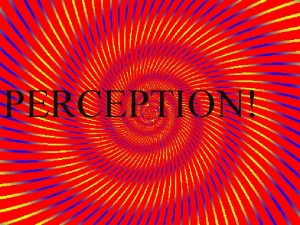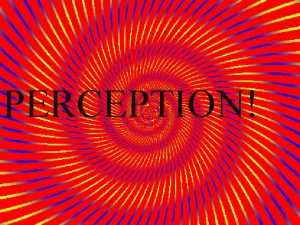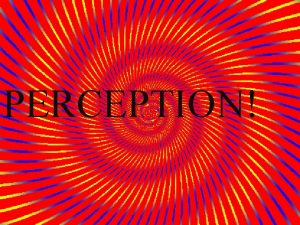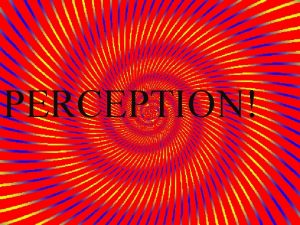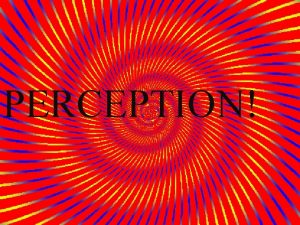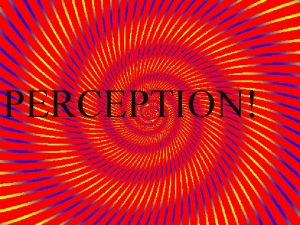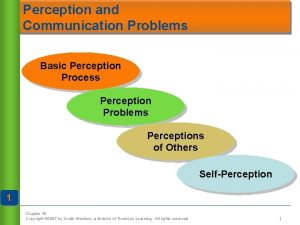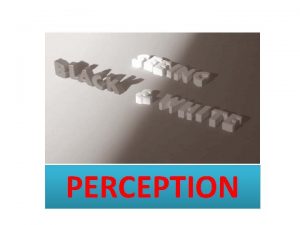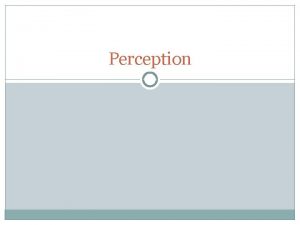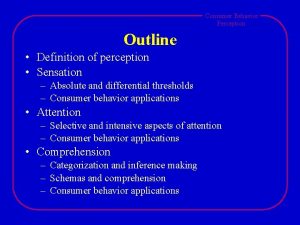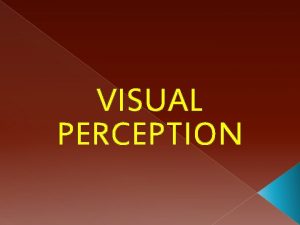CHAPTER THREE PERCEPTION 1 PERCEPTION DEFINITION Perception is





















- Slides: 21

CHAPTER THREE PERCEPTION 1

PERCEPTION- DEFINITION Perception is the process through which the information from outside environment is selected, received, organised and interpreted to make it meaningful to you. 2

Environmental stimuli Observation Perceptual selection Perceptual organization Interpretation Response 3

MAJOR INFLUENCES ON THE PERCEPTION PROCESS Characteristics of the: Perceiver- needs, values, experiences, attitudes Perceived- appearance, communication, behaviour Situation- physical location, social setting, organizational setting 4

PERECPTUAL SELECTION Is the process by which people filter out most stimuli so that they can deal with the most important ones. 5

EXTERNAL PERCEPTION FACTORS are characteristics that influence whether stimuli will be noticed. * Size * intensity * Contrast * Motion * Repition * Novelty * Familiarity * Order 6

INTERNAL PERCEPTION FACTORS are aspects of the perceiver that influence perceptual selection. * Personality dimension- field dependence/independence * Learning- past experience * Motivation 7

PERCEPTUAL ORGANIZATION Is the process by which we group outside stimuli into recognisable and identifiable patterns and whole objects. 8

FIGURE GROUND PRINCIPLE Means we tend to be attentive to such perceived objects that standout against a background. 9

PERCEPTUAL GROUPING Is the perceptual organization process of placing people and objects into recognisable and manageable patterns or categories. 10

BARRIERS TO PERCEPTUAL ACCURACY Errors in judging people/situation * Similarity error * Contrast error * Overweighing positive information * Race, sex and age bias * First impression error * Recency error 11

ERRORS MADE IN PEOPLE PERCEPTION 1. 2. 3. 4. 5. Perceptual defense Stereotyping Halo effect Expectancy effect Projection 12

1. PERCEPTUAL DEFENSE Is the tendency for people to protect themselves against ideas, objects or situations that are threatening 13

2. STEREOTYPING Is the tendency to assign attributes to someone solely on the basis of a category of people of which that person is a member. 14

3. HALO EFFECT Is the tendency to judge a person entirely on the basis of a single trait which may be favourable or unfavourable 15

4. EXPECTANCY EFFECT In the perceptual process are the extent to which prior expectation bias perception of events, objects and people 16

5. PROJECTION Is the tendency of people to see their own traits in other people. 17

ATTRIBUTION THEORY When individuals observe behaviour, they attempt to determine whether it is internally or externally caused. 18

FUNDAMENTAL ATTRIBUTION ERROR Is the tendency to underestimate the influence of external factors and overestimate the influence of internal factors when marking judgment about the behaviour of others. 19

SELF SERVING BIAS Is the tendency for individuals to attribute their own successes to internal factors while putting the blame for failures on external factors. 20

PERCEPTION AND OB n n n Employment interview Performance expectations Performance evaluation Individual decision making Impression management 21
 Chapter 5 sensation and perception
Chapter 5 sensation and perception Color vision
Color vision Chapter 3 sensation and perception
Chapter 3 sensation and perception Chapter 6 sensation and perception
Chapter 6 sensation and perception Chapter 4 sensation and perception test
Chapter 4 sensation and perception test Five basic tastes
Five basic tastes Sensation perception
Sensation perception Chapter 7 managing risk vision and perception
Chapter 7 managing risk vision and perception Chapter 4 sensation and perception
Chapter 4 sensation and perception Chapter 3 sensation and perception
Chapter 3 sensation and perception Perception check definition
Perception check definition Pecetion
Pecetion Environmental perception definition ap human geography
Environmental perception definition ap human geography Self perception theory definition
Self perception theory definition Perception checking definition
Perception checking definition Define monocular cues
Define monocular cues Three hobbits and three orcs
Three hobbits and three orcs Othello act 3 summary
Othello act 3 summary In three minutes write
In three minutes write Signs have three purposes, identify the three.
Signs have three purposes, identify the three. The three colonial sections-one society or three
The three colonial sections-one society or three Three addresses in three address code are
Three addresses in three address code are

